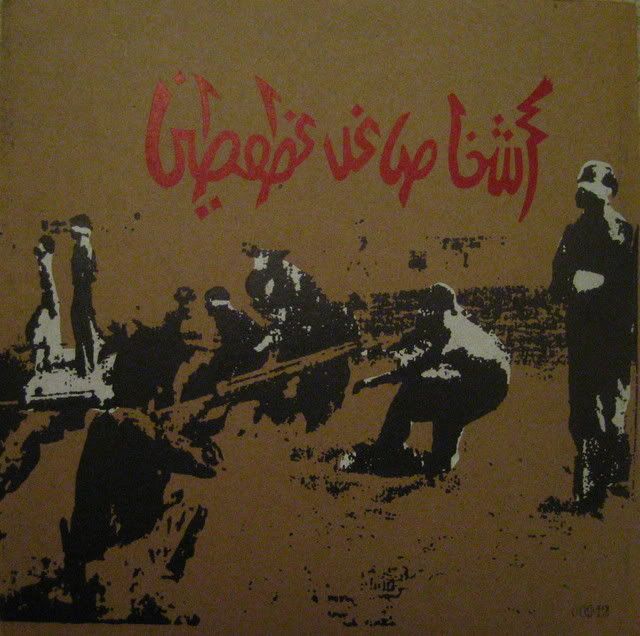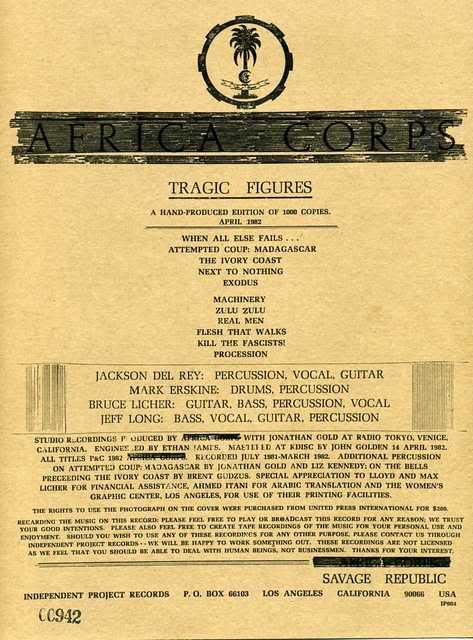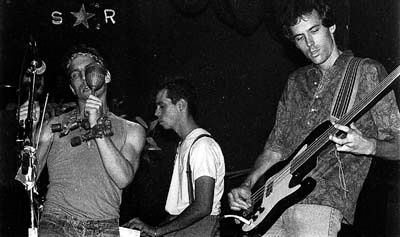

When All Else Fails / Attempted Coup: Madagascar / The Ivory Coast / Next To Nothing / Exodus
Machinary / Zulu Zulu / Real Man / Kill The Fascists / Procession

The Africa Corps (Savage Republic) debut LP, limited to 1000 hand printed copies, was released in 1982. Lots of great music to chew on with this excellent release. This LP sounds a little more ‘industrial’ to the 1983 Savage Republic ‘post punk’ 7″ single that is uploaded elsewhere on this site. ‘Kill The Fascist’ could well be a Test Department track a couple of years too early. A beautiful LP to look at, all individually screen-printed on a very ‘heavy’ card sleeve (my copy is written in Arabic on the centre labels, as well as the front sleeve – other LP’s are all slightly different). This release also has rich textures within the grooves as well as the packaging and simply must be listened to.
Text below courtesy of furious.com

Savage Republic came together as the Africa Corps at UCLA in 1981. Two years earlier, band-leader-to-be Bruce Licher’s discovery of the No Wave scene, and specifically DNA, led to his deciding to finally pick up a guitar after having been a huge Ventures fan all through high school. The No Wave scene had heavily shaped the Gun Club guitarist Kid Congo’s view of his instrument. Like Kid, most of the players in Savage Republic were more interested in soundmaking than conventional technique. To quote later member Thom F ‘When I think of SR, I don’t think of musicians. I think of soundmakers. I had only been playing bass one year when I joined SR (and it showed). Musicianship isn’t everything. We all brought something different to the table and that’s what makes SR special.’
Shortly after picking up the guitar, Bruce Licher now leader of Arizona’s Scenic had joined the band Neef. Neef had decided to stick out a single following their friends the Urinals earlier record release. Following the release of this Neef single, Licher had decided to do a 7″ for the Independent Project course he was on. This would lead to the formation of his record label Independent Projects. This single was released under the title of Project 197 and featured Mark Erskine (later SR drummer), Kevin Barrett (Urinals drummer) and Brent Wilcox (Neef mainman) also assisted. Two other 7″ singles followed before work started on the debut LP for Africa Corps. Prior to the Africa Corps, Bruce had been exploring the tonalities of playing in the tunnels under UCLA leading to his aggregate crew being known as the Tunneltones.
This was a straighter rock version of another project called Bridge that he was doing at the same time, which contained the same members. “Bruce Dan Voznick was my main partner in Bridge (he was also vocalist in the group Afterimage) and he and I shared guitar and bass duties. We drafted a film student friend named Michael Gross to do vocals through a megaphone, and Mark Erskine to play scrap metal percussion (which, for the live Bridge shows was a pile of scrap printing plates that he hit with a 2×4).”
Mark Erskine was Bruce’s course mate, who he’d seen doing a percussion work on a performance art course he was on. Soon after they started practising in the parking space/tunnels Bruce’s ex Them Rhythm Ants bandmate Phil Drucker (at the time known as Jackson Del Rey) talked his way into playing along with them. Drucker was in contact with a 16 year old bassist named Jeff Long who was interested in learning to play experimentally and became involved in the project. As Bruce describes Long, “he was a bass prodigy and had already played with some heavy jazz players, loved Jaco Pastorius, and was starting to get into punk rock and looking to stretch out into new things. He was a friend of Phil’s, and apparently they had played in some band previously, though I never got any details.” These 4 would form the line up that would record the band’s first LP Tragic Figures.
While the band was still rehearsing in Bruce’s apartment in West L.A., Licher caught guitar orchestra composer Glen Branca’s first west coast gig at Cal Arts gallery in Valencia. Bruce recalls “there were 6 people in his group total, and the 10-15 minutes they spent tuning were mesmerizing. He then performed 4 pieces and I’d never heard anything like it. By the middle of the fourth piece, I was hearing sounds I couldn’t see anybody playing, no doubt from the overtones bouncing around and off the walls of the gallery space. After the performance I went up to tell him how much I enjoyed it, and to ask about the tuning of the guitars. All the way home all I could think of was “I’ve got to try tuning my guitar like that.” And that’s exactly what we did at the next SR (actually Africa Corps at that point) rehearsal I had gone and bought a bunch of B strings for my guitar and strung it all up with 6 B strings.’
This is the same basic idea as behind the guitar credited on the first Velvet Underground LP as Ostrich guitar. This was also the predecessor to the instrument the band may well be best known for, the white 12 string Hagstrom guitar called the Monotone which is responsible for a lot of the more Eastern sounding textures on the bands’ recordings. At the time, Bruce was using a cheap Fender Stratocaster copy, which was followed by another Strat, then came the Hagstrom because Bruce couldn’t afford to go for a Rickenbacker. Up until he corrected me, I was convinced he was using a Gibson SG, possibly because I always link it to classic psychedelic era players. For a similar reason it would’ve been weird if he had got the Rickenbacker since it’s the guitar always linked to the jangle of the Byrds.
I wondered if there was a conscious attempt to break away from previous connections. Bruce: “There was always an attempt to break away from standard anything in Savage Republic. From the get-go, the idea was to try something new, to break down the boundaries, and see if we could take things somewhere they hadn’t been taken before. Even if occasionally we started from somewhere someone else had been (Faust’s “Krautrock” turning into “Exodus,” or that obscure Ventures tune turning into “Attempted Coup: Madagascar”) we always tried to find sounds or a way to put things together that hadn’t been done before. And even if later on the sounds got a bit more sophisticated or less experimental, I think there was always an intention to make music that sounded like nobody else out there. And to a great extent I think we succeeded. Even with Scenic, I still am very pleased that none of our records sound like any other band out there.”
At that time, Bruce had also recently bought a copy of the Faust IV album. This was not the only krautrock influence on the band from the start; Bruce also cites both Popul Vuh and Amon Duul II. With Faust IV, Bruce was really taken with the sonic drone of the song “Krautrock,” and played it for Phil, Jeff and Mark. ‘I suggested we try something along those lines, so Jeff started up a simple, repetitive bass line, Phil & Mark got a gamelan-style percussion beat going on a metal rail and pipes, and I started droning on what became known as our “monotone” guitar. Lo and behold, the melody I came up with reminded us of the theme music to the movie “Exodus,” so guess what we decided to call the song? Still one of my favorite SR songs of all time, especially the parking garage version which appears on the Independent Projects 10″ box set’.
Tragic Figures was originally recorded under the band name Africa Corps. After it was recorded and the sleeve had been printed, Drucker announced that he was unhappy with the connotations of the band name. Bruce: ‘when Phil laid down the ultimatum that we had to change our name or he would leave the band just as our first album was about to be released we spent a couple days brainstorming on what might be an appropriate new name for the band. We’d recently done some explosive shows in LA – one at Al’s Bar that a friend had said was like a war zone on stage, so “Savage” seemed to fit. And the idea of a “Republic” also seemed to fit, as we did everything ourselves booked the shows, flyered, wrote all the music, made all the band decisions, did our own recordings, album covers, etc. Just like most every other band that wasn’t on a major or trying to be. But somehow, as conceptual art students we liked the idea of stating the obvious in a conceptual way, and I think somehow both Phil and I were drawn to the idea that we were establishing our group as something a bit more substantial, and we liked the idea of calling ourselves a “republic.” I remember thinking of the name “Savage Republic,” during the brainstorming and almost saying something, then discarding the idea because it seemed “too obvious.” Just like an art student to think he has to be more mysterious or obtuse or something. Then Phil said “what about Savage Republic?” It seems the name was hovering around in the ether that day, and we both sort of plucked it out, though Phil was the first to verbalize it. And it quickly became obvious that that was the right name for us.’
The name had been a problem before, with people approaching the band admiring Africa Corps’ apparent Nazi connection, Drucker was Jewish so its appreciable that he wouldn’t like such thought. There was also a band called Africa Korps on the East coast, which in itself may have created problems. Licher was left having to print ‘Savage Republic’ over every place that the original sleeve said ‘Africa Corps.’ The legacy of the original band name remains in the usage of an altered Africa Corps logo for the band merchandise. Bruce substituted an Islamic Crescent and Star for the original Nazi Swastika thus hopefully removing the original connotations.
This LP is the most punk sounding the band got. Beneath the murk in the mix the band sounds like a cerebral hardcore band with a funky rhythm section playing eastern tinged surf music covers of serial music. I tend to group it alongside such mavericks as the first Meat Puppets releases and D.A.F.’s Die Kleinen und Die Bosen, both of which came out in the same year. It definitely shares the same qualities of pushing against the barriers of what could be seen as punk music while retaining the same raw edge that less musically ambitious bands had. This may be down to the band not yet being entirely used to their instruments, a quality that Bruce has said elsewhere led to reinterpretation. Here things were made slightly awry because Mark was dabbling with psychedelics all the way through his time in the band and it had a negative effect on him in the long run. This caused some hairy events just before the recording of “Ivory Coast,” otherwise one of Tragic Figures most memorable tracks, leading to drum tracks not being quite as strong as they could be.
The original sleeve features the firing squad execution of an Arab Dissident, according to Ethan Port, ‘It’s an Iranian college professor, who’s hand is bandaged from being broken. He was the history professor of a UCLA student who lived in the UCLA Cooperative Student Housing with me in the 1980’s.’ I was afraid that such images would mean that the reissue campaign of late last year would be delayed if not halted by happenings in Afghanistan; luckily this wasn’t to be the case, not for very long anyway. The French Sordide Sentimentale release used a different, abstract image, presumably because of the political ambiguity of the image.
Bassist Jeff Long was then sharing his time between Savage Republic and a band called Wasted Youth. For a while it seemed that Wasted Youth were a better prospect, but Jeff regretted this when Tragic Figures started getting good press. By this time, Drucker had asked fellow UCLA student Robert Loveless to join the band who therefore became a five piece (Loveless is currently working with Bruce Licher again as a member of Scenic). At the time he started working with SR, he was very interested in keyboards amongst the normal multi-instrumentation that seems typical of all the members of the band. This change of lineup was taking the band into a far softer direction than they’d had before, possibly indicated by the sound of the later Ceremonial. This lead to a short term name-change to Final Republic. Bruce: ‘Final Republic was the name that Phil, Robert, Mark & I performed under for several shows right around the time that Tragic Figures came out and Jeff Long had left the band temporarily. The sound was starting to change and it didn’t seem as “savage” anymore as it was starting to head in the “Film Noir / 17 Pygmies Jedda By The Sea” direction, so we decided to shift the name a bit. Then Jeff came back and we became the 5-piece SR again until after the Mojave Exodus show in 1983 when Jeff left for good.’
Nic
May 10, 2009 at 10:22 amGreat group – and a really good choice for an upload Penguin…
‘Exodus’ is probably my favourite on the wax – a great Post Punk raga…
I really like the later album ‘Customs’ LP: there are some brainhuffing heavy jams on there rich with Peter Hook-esque basslines and detuned guitars…
I remember reading a review of a Neef / Bridge etc concert back in an early issue of Flipside magazine (the one with the ‘RIP Darby Crash’ cover and the large Black Flag interview) and it seemed really exciting: evocative references to metal bashing, shouting through megaphones, films being played over the groups…Very inspiring (funny how a couple of paragraphs of text can grab your attention and remain in your memory for so long)…
Ian S
May 13, 2009 at 11:36 amDidn’t know Savage Republic had earlier gone under the name of Africa Corps.
They were a great band live, and remember them playing at Barrowland Revue bar (small venue under the main ballroom) in Glasgow about 1990.
Sadly the gig was mid-week, and it was usually difficult to get a decent-sized crowd there on anything other than Fridays to Sundays. Maybe about 100-150 turned up.
Savage Republic nonetheless put on a fine performance and audience members up on stage helping out with the percussion. They came across as very decent kind of people and played some excellent music.
Glen
January 15, 2011 at 10:39 amNice post you have given great information about the music.